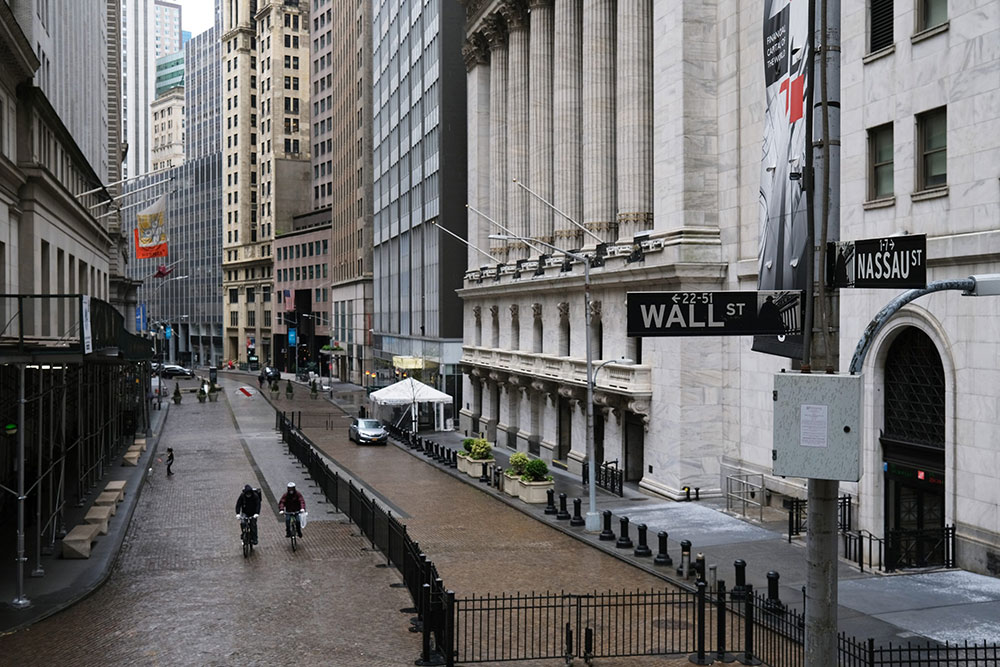为什么美股散户在特殊时期的损失最为惨重?

在COVID-19疫情期间,美国股市的散户可能损失特别惨重,但原因并不只是因为过去两个月的整体市场下滑。
在多个因素的共同影响下,散户(又称零售投资者)进行了史上最糟糕也是最有价值破坏性的投资行为。投资者进入高风险市场的途径增多,零成本投资方式兴起,向非专业投资者发放的信贷额度达到史无前例的水平,投资者没有其他方式展现自己的冒险行为等,这些因素导致许多散户在不完全了解的情况下,一头扎进了充满波动性的、不透明的市场中,迅速损失大量资金。
从数据中已经能够看出这种破坏性行为的表现。通常情况下,只有机构投资者才能进入期货市场。但我们看到,2020年前三个月,E-迷你标普500(E-mini S&P 500)期货合约(该证券的设计目的就是为了吸引散户投资者,因为其成本低于标普500期货合约)隔夜交易中的日平均交易量增加了近一倍。在同样高风险的期权市场,今年1月至3月期间,平均月交易量增加了58%。
对于普通投资者的投资组合而言,这已经足够令人担忧,但美国股市的消息更糟糕:散户投资者卖空交易的数量大幅增加,而在做空市场时,投资者的损失可能是无底洞。3月23日,随着美国高市值公司的股票走出低谷,SPY(另外一款深受散户投资者喜爱的投资产品,以标普500指数为标的)的空头净额为500亿美元。接下来三个星期,空头净额扩大到660亿美元,但与此同时,美国大盘股反弹了近25%。这意味着散户投资者匆忙做空,又额外损失了40亿美元。
散户为什么能够进入这些市场,进行这些大胆的操作呢?归根结底,主要原因在于雨后春笋般出现的零成本交易平台。这些平台支持散户免费购买基金。过去两年,Robinhood等服务的兴起迫使E*Trade和富达国际(Fidelity)等传统机构也推出了类似计划。
除了零成本交易以外,还有许多初创交易平台为散户投资者提供高于正常水平的透支金额(投资贷款),投资者不需要支付太多现金,而且这些平台还为投资者进入高风险的期权和期货市场提供了便利的途径。投资者只需要在手机上点击几下,就能通过这些公司的应用程序,在期权和期货市场进行交易——在只有1万美元的情况下通过贷款进行10万美元的交易。
除了风险以外,另外一个问题是投资者认为在新市场交易需要付出哪些成本。在传统的股票市场投资中,交易成本是明码标价的(例如,每笔交易有固定的手续费),但在期权市场和其他衍生品市场却截然不同。在这些市场中,真实的成本是隐性成本,隐藏在买卖价差当中,投资者往往难以发现,因此大部分散户在作出投资决策时并不会考虑这些成本。所以,交易一种衍生品的显性成本即使为零,投资者每次交易的时候可能因为隐性成本损失10%甚至更高的投资金额。
新冠疫情迫使大部分白领只能在家办公,许多人以前日常生活中有一些小小的乐趣,比如集体体育活动,开怀畅饮或者体育博彩等,现在却没有了宣泄的出口。Reddit用某些投资者用一笔小投资一夜之间获利百万美元的故事,填补了人们内心的空虚。这让待在家中无聊的散户们心生希望,认为自己也能一夜暴富。但事实上,投资者在这些市场中进行的“零成本”交易越多,累积的手续费就越高,就会对其长期投资造成更大的破坏。
今年,眼睁睁看着股市暴跌确实会让人陷入恐慌,但散户投资者应该抵御住诱惑,不要指望依靠衍生品市场交易来弥补投资组合损失。散货投资者现在更应该牢记金融课里的基本观点:最大程度降低成本,抑制住试图把握大盘时机的冲动,是对投资组合的未来最好的选择。(财富中文网)
本文作者德莱克·霍斯特梅耶是乔治梅森大学(George Mason University)商学院的金融学专业副教授。
翻译:刘进龙
审校:汪皓
在COVID-19疫情期间,美国股市的散户可能损失特别惨重,但原因并不只是因为过去两个月的整体市场下滑。
在多个因素的共同影响下,散户(又称零售投资者)进行了史上最糟糕也是最有价值破坏性的投资行为。投资者进入高风险市场的途径增多,零成本投资方式兴起,向非专业投资者发放的信贷额度达到史无前例的水平,投资者没有其他方式展现自己的冒险行为等,这些因素导致许多散户在不完全了解的情况下,一头扎进了充满波动性的、不透明的市场中,迅速损失大量资金。
从数据中已经能够看出这种破坏性行为的表现。通常情况下,只有机构投资者才能进入期货市场。但我们看到,2020年前三个月,E-迷你标普500(E-mini S&P 500)期货合约(该证券的设计目的就是为了吸引散户投资者,因为其成本低于标普500期货合约)隔夜交易中的日平均交易量增加了近一倍。在同样高风险的期权市场,今年1月至3月期间,平均月交易量增加了58%。
对于普通投资者的投资组合而言,这已经足够令人担忧,但美国股市的消息更糟糕:散户投资者卖空交易的数量大幅增加,而在做空市场时,投资者的损失可能是无底洞。3月23日,随着美国高市值公司的股票走出低谷,SPY(另外一款深受散户投资者喜爱的投资产品,以标普500指数为标的)的空头净额为500亿美元。接下来三个星期,空头净额扩大到660亿美元,但与此同时,美国大盘股反弹了近25%。这意味着散户投资者匆忙做空,又额外损失了40亿美元。
散户为什么能够进入这些市场,进行这些大胆的操作呢?归根结底,主要原因在于雨后春笋般出现的零成本交易平台。这些平台支持散户免费购买基金。过去两年,Robinhood等服务的兴起迫使E*Trade和富达国际(Fidelity)等传统机构也推出了类似计划。
除了零成本交易以外,还有许多初创交易平台为散户投资者提供高于正常水平的透支金额(投资贷款),投资者不需要支付太多现金,而且这些平台还为投资者进入高风险的期权和期货市场提供了便利的途径。投资者只需要在手机上点击几下,就能通过这些公司的应用程序,在期权和期货市场进行交易——在只有1万美元的情况下通过贷款进行10万美元的交易。
除了风险以外,另外一个问题是投资者认为在新市场交易需要付出哪些成本。在传统的股票市场投资中,交易成本是明码标价的(例如,每笔交易有固定的手续费),但在期权市场和其他衍生品市场却截然不同。在这些市场中,真实的成本是隐性成本,隐藏在买卖价差当中,投资者往往难以发现,因此大部分散户在作出投资决策时并不会考虑这些成本。所以,交易一种衍生品的显性成本即使为零,投资者每次交易的时候可能因为隐性成本损失10%甚至更高的投资金额。
新冠疫情迫使大部分白领只能在家办公,许多人以前日常生活中有一些小小的乐趣,比如集体体育活动,开怀畅饮或者体育博彩等,现在却没有了宣泄的出口。Reddit用某些投资者用一笔小投资一夜之间获利百万美元的故事,填补了人们内心的空虚。这让待在家中无聊的散户们心生希望,认为自己也能一夜暴富。但事实上,投资者在这些市场中进行的“零成本”交易越多,累积的手续费就越高,就会对其长期投资造成更大的破坏。
今年,眼睁睁看着股市暴跌确实会让人陷入恐慌,但散户投资者应该抵御住诱惑,不要指望依靠衍生品市场交易来弥补投资组合损失。散货投资者现在更应该牢记金融课里的基本观点:最大程度降低成本,抑制住试图把握大盘时机的冲动,是对投资组合的未来最好的选择。(财富中文网)
本文作者德莱克·霍斯特梅耶是乔治梅森大学(George Mason University)商学院的金融学专业副教授。
翻译:刘进龙
审校:汪皓
Individual investors may be about to lose prodigious amounts of money during the COVID-19 pandemic—but it’s not simply due to the overall market drop over the past two months.
A confluence of factors has come together to bring about some of the worst and most value-destroying behavior by individual investors, also known as retail investors, in history. Newly granted access to high-risk markets, the appearance of zero-cost investing, historic levels of credit extended to nonprofessional traders, and an absence of other outlets for risk-taking behavior have all combined to produce a situation where many retail investors are losing money hand over fist in volatile and opaque markets they don’t fully understand.
We are beginning to see this destructive behavior play out in the data. For futures markets, something normally only accessed until recently by institutional investors, we have seen average daily volume in overnight trading nearly double in the first three months of 2020 for the E-mini S&P 500 futures contract (a security specially designed to attract retail investors due to its lower cost than the total S&P 500 contract). In the equally high-risk options markets, average monthly trading volumes jumped 58% between January and March of this year.
While this is worrisome for the average investor’s portfolio, the news in the U.S. stock market is even worse—namely the severe jump in retail investors short selling, a bet against the market where losses for investors are potentially unlimited. As equities of U.S. companies with high market capitalization (also known as large-cap stocks) bottomed out on March 23, short interest on the SPY (another favorite of retail traders that tracks the S&P 500) sat at $50 billion. Short interest expanded over the next three weeks to $66 billion, but at the same time U.S. large-cap stock rebounded almost 25%. This implies that an additional $4 billion was lost over that period as retail investors rushed to short the position.
How did retail investors gain such broad access to these markets and begin to make such bold bets? Much of this can be traced back to the proliferation of what are widely known as zero-cost trading platforms, which allow individual investors to purchase funds with no fees. Over the past two years, the rise of services like Robinhood has forced traditional players like E*Trade and Fidelity to offer similar plans.
In addition to zero-cost trades, many of these startup trading platforms offer individual investors higher-than-normal amounts of margin (loans for investing) while requiring little money down, as well as easy access to high-risk options and futures markets. These companies’ apps make trading in these markets as easy as one or two taps on a phone—you can place $100,000 in trades instantly with a balance of just $10,000.
The problem here, aside from the risk taking, is what the investor believes are the costs of trading in these new markets. Unlike traditional investing in stock markets where the costs to trade are explicit (for example, a flat fee per trade placed), in options and other derivative markets the true costs are implicit and hidden to the average investor in things such as the bid-ask spread—something most retail investors don’t factor into their decision making. So even if the explicit costs to trade are zero, investors can lose 10% or more of their investment in implied costs every time they trade a derivative.
The coronavirus crisis has forced most white-collar employees to work from home, leaving many with no outlet for the small pleasures they used to enjoy in everyday life, such as group sports activities, going out for drinks, or betting on sports. Reddit is filled with tales of some investor turning a small investment into a million-dollar gain overnight. This gives that homebound, bored retail investor some hope that they can do it too. Yet the truth is that the more “zero-cost” trades the investor places in these markets, the more fees they rack up and the more they destroy their long-term investments.
It is a scary time for those who have watched the stock market plunge this year, but retail investors need to resist the allure of trading in derivatives markets as a way to make up for portfolio losses. Now more than ever, individual investors need to remember the basics of Finance 101: minimizing costs and resisting the urge to try to time the market is the best thing one can do for their portfolio’s future.
Derek Horstmeyer is an associate professor of finance at the George Mason University School of Business.













